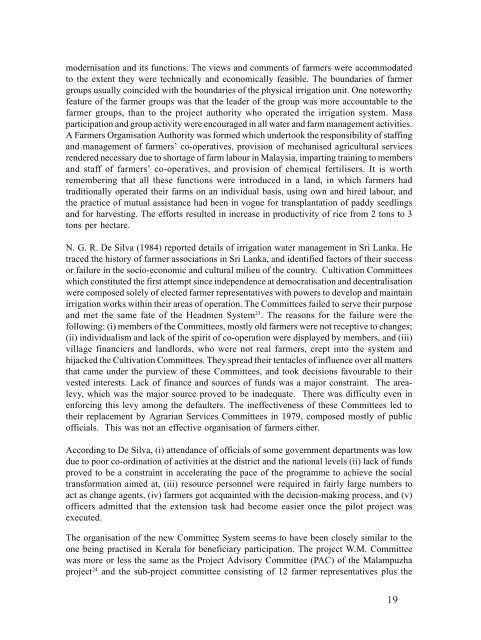Beneficiary Participation in Irrigation Water Management: The Kerala
Beneficiary Participation in Irrigation Water Management: The Kerala
Beneficiary Participation in Irrigation Water Management: The Kerala
You also want an ePaper? Increase the reach of your titles
YUMPU automatically turns print PDFs into web optimized ePapers that Google loves.
modernisation and its functions. <strong>The</strong> views and comments of farmers were accommodated<br />
to the extent they were technically and economically feasible. <strong>The</strong> boundaries of farmer<br />
groups usually co<strong>in</strong>cided with the boundaries of the physical irrigation unit. One noteworthy<br />
feature of the farmer groups was that the leader of the group was more accountable to the<br />
farmer groups, than to the project authority who operated the irrigation system. Mass<br />
participation and group activity were encouraged <strong>in</strong> all water and farm management activities.<br />
A Farmers Organisation Authority was formed which undertook the responsibility of staff<strong>in</strong>g<br />
and management of farmers’ co-operatives, provision of mechanised agricultural services<br />
rendered necessary due to shortage of farm labour <strong>in</strong> Malaysia, impart<strong>in</strong>g tra<strong>in</strong><strong>in</strong>g to members<br />
and staff of farmers’ co-operatives, and provision of chemical fertilisers. It is worth<br />
remember<strong>in</strong>g that all these functions were <strong>in</strong>troduced <strong>in</strong> a land, <strong>in</strong> which farmers had<br />
traditionally operated their farms on an <strong>in</strong>dividual basis, us<strong>in</strong>g own and hired labour, and<br />
the practice of mutual assistance had been <strong>in</strong> vogue for transplantation of paddy seedl<strong>in</strong>gs<br />
and for harvest<strong>in</strong>g. <strong>The</strong> efforts resulted <strong>in</strong> <strong>in</strong>crease <strong>in</strong> productivity of rice from 2 tons to 3<br />
tons per hectare.<br />
N. G. R. De Silva (1984) reported details of irrigation water management <strong>in</strong> Sri Lanka. He<br />
traced the history of farmer associations <strong>in</strong> Sri Lanka, and identified factors of their success<br />
or failure <strong>in</strong> the socio-economic and cultural milieu of the country. Cultivation Committees<br />
which constituted the first attempt s<strong>in</strong>ce <strong>in</strong>dependence at democratisation and decentralisation<br />
were composed solely of elected farmer representatives with powers to develop and ma<strong>in</strong>ta<strong>in</strong><br />
irrigation works with<strong>in</strong> their areas of operation. <strong>The</strong> Committees failed to serve their purpose<br />
and met the same fate of the Headmen System 23 . <strong>The</strong> reasons for the failure were the<br />
follow<strong>in</strong>g: (i) members of the Committees, mostly old farmers were not receptive to changes;<br />
(ii) <strong>in</strong>dividualism and lack of the spirit of co-operation were displayed by members, and (iii)<br />
village f<strong>in</strong>anciers and landlords, who were not real farmers, crept <strong>in</strong>to the system and<br />
hijacked the Cultivation Committees. <strong>The</strong>y spread their tentacles of <strong>in</strong>fluence over all matters<br />
that came under the purview of these Committees, and took decisions favourable to their<br />
vested <strong>in</strong>terests. Lack of f<strong>in</strong>ance and sources of funds was a major constra<strong>in</strong>t. <strong>The</strong> arealevy,<br />
which was the major source proved to be <strong>in</strong>adequate. <strong>The</strong>re was difficulty even <strong>in</strong><br />
enforc<strong>in</strong>g this levy among the defaulters. <strong>The</strong> <strong>in</strong>effectiveness of these Committees led to<br />
their replacement by Agrarian Services Committees <strong>in</strong> 1979, composed mostly of public<br />
officials. This was not an effective organisation of farmers either.<br />
Accord<strong>in</strong>g to De Silva, (i) attendance of officials of some government departments was low<br />
due to poor co-ord<strong>in</strong>ation of activities at the district and the national levels (ii) lack of funds<br />
proved to be a constra<strong>in</strong>t <strong>in</strong> accelerat<strong>in</strong>g the pace of the programme to achieve the social<br />
transformation aimed at, (iii) resource personnel were required <strong>in</strong> fairly large numbers to<br />
act as change agents, (iv) farmers got acqua<strong>in</strong>ted with the decision-mak<strong>in</strong>g process, and (v)<br />
officers admitted that the extension task had become easier once the pilot project was<br />
executed.<br />
<strong>The</strong> organisation of the new Committee System seems to have been closely similar to the<br />
one be<strong>in</strong>g practised <strong>in</strong> <strong>Kerala</strong> for beneficiary participation. <strong>The</strong> project W.M. Committee<br />
was more or less the same as the Project Advisory Committee (PAC) of the Malampuzha<br />
project 24 and the sub-project committee consist<strong>in</strong>g of 12 farmer representatives plus the<br />
19










